Tiny House Stoves, Cooktops & Ranges
There are many options for cooking in a tiny house. If you are not opposed to using propane in your house (and are already using it for an on-demand, tankless water heater) I highly recommend cooking with propane gas. Propane is far more efficient than electricity for any heating element and in most cases leads a better cooking experience.
Propane can be used in smaller RV-style ranges, marine ranges (higher quality stainless steel), permanently installed stovetops and portable cooktops. If you prefer to use electricity, one efficient solution would be to use a portable induction cooktop, which can be stored in a cabinet or under a counter when not in use.
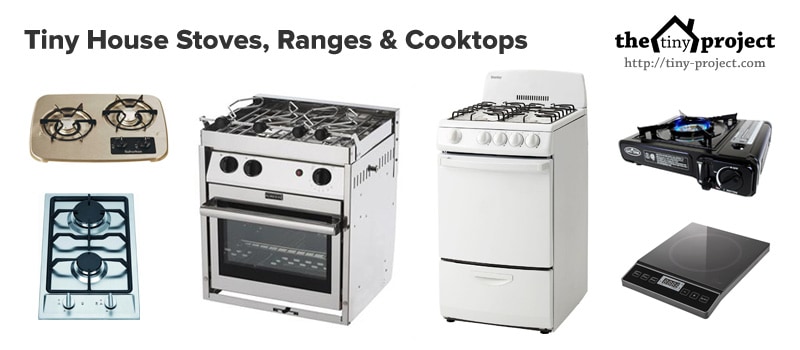
Options for all of these are shown below, with some pros and cons of each style.
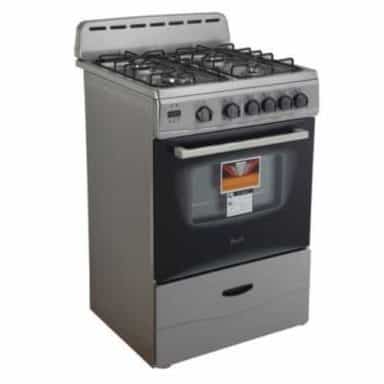 Small / RV Ranges
Small / RV Ranges
If you're looking for a full range (oven included), the most affordable option is usually a smaller 20" or 24" range made by companies like Avanti, Danby, etc. These models typically start around $500.
Atwood (the RV product manufacturer) also makes small ranges that I'd lump into this category.
Pros: The benefits of this kind of range is that you usually get 4 burners and a reasonably sized oven, just like the normal stove you are used to in a traditional house. The narrower 20' models (more common in Europe) do have slightly smaller burners (a little tight for a 12" skillets!)
Cons: The downside to these ranges is that they usually have mediocre reviews and are designed to compete on low price and small size, but do not necessarily provide the best possible cooking experience or durability.
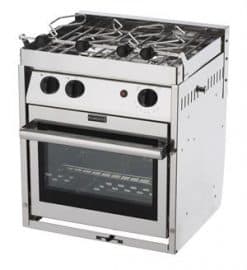 Marine Ranges
Marine Ranges
A marine-style range is one designed for sailboats (or yachts) and therefore built for a much more extreme salt-water environment with constant movement. These ranges (and stovetops) are most always built out of solid stainless steel, so they are very durable and of higher quality. Look for brands such as Force 10 and Dickinson (yes, the same company that also makes stainless propane fireplaces). Origo also makes similar stoves that burn alcohol instead of propane.
These models are smaller in size and typically come in 2-burner or 3-buners configurations (sometimes 4).
Pros: The upside to a marine range is it's stainless finish and solid build quality -- designed to withstand corrosion and constant movement. I've got to say they are pretty sexy!
Cons: The downside to these models is that they are quite expensive. Most start at $1,200 (if you're lucky) and go up from there. You're probably gonna pay more like $1,500. The other con is that they are typically smaller in size, particularly the oven (think half an oven). The small size (in my case, and many others I'm sure) can be a plus, depending on your kitchen design.
My experience: I have a Seaward 2-burner range in my house (and I love it!), but they've discontinued their line of ranges, so unfortunately it's no longer available.
DickinsonMediterranean 3 Burner Propane Galley Range
Force 10 Three-Burner Gourmet Galley Gimbaled Propane Ranges
Propane Stovetops
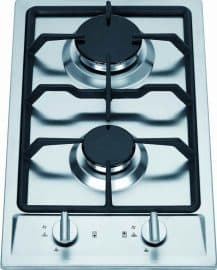 I propane stovetop is a great choice if you don't think you need an oven (or you use a separate convection oven or microwave). These will be far less expensive than a full range. There are many options from higher-end stainless steel models down to simpler RV-style 2-burner models. Pay attention to the materials used and how easy each might be to clean.
I propane stovetop is a great choice if you don't think you need an oven (or you use a separate convection oven or microwave). These will be far less expensive than a full range. There are many options from higher-end stainless steel models down to simpler RV-style 2-burner models. Pay attention to the materials used and how easy each might be to clean.
Pros: These units are usually permanently installed on top of the counter. They are great because they don't take up an under-counter space, so you might free up more storage space in the kitchen. They are cheaper and usually start at $100, going up from there.
Cons: The downside is they don't include an oven, of course, and they usually only include 2 burners. If you are a serious cook, you'd probably want to go with the full range option above.
 Portable Propane Cooktops
Portable Propane Cooktops
Portable propane cooktops are a great option for people who cook less often and want to free up some counter space when their stove is not in use. These models still give you the gas cooking experience, but in a small, portable package that can be stored in a cabinet or under the counter when not in use.
Pros: A portable propane cooktop like this is one of the cheapest options, with highly-rated models only costing $25.
Cons: However, they are usually not designed for constant use, so someone who cooks on a daily basis might want something more substantial.
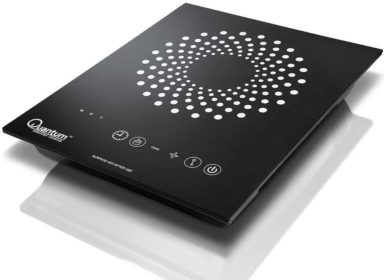 Induction Burners
Induction Burners
Induction burners are the only option on this list that do not use propane. I include them here because they use a very interesting technology that many believe is the safest and most efficient way to cook with electricity.
Pros: If you are a light cooker you may choose this option. As with the portable propane cooktops above, these would allow you to stow your stove when not in use to free up limited counter space in a tiny house kitchen. They are also very efficient in their use of electricity (no wasted heat coming out in all directions) and they are quick to supply heat.
If you are opposed to the use of propane in your house, this may be the best option.
Cons: The biggest downside is that they are only compatible with induction-ready cookware (must include iron -- many aluminum, copper or glass pots or pans won't work). These cooktops heat using induction (direct electromagnetic transfer) which means they remain cool to the touch, even when in use.
Prices start around $50, with highest-rated models around $60 each.



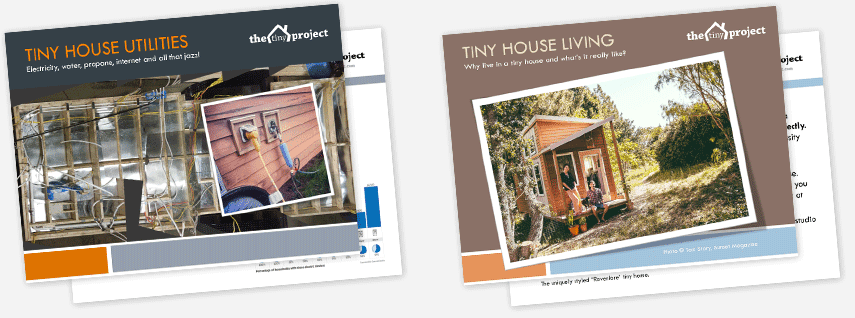
Alek, the portable 'propane' stoves that you show that are under $25 at Asian grocery stores actually use butane canisters. They don't smell, or produce water vapor as propane does, (so I've read) and are used widely in Asian homes. They're great for stir-fry, take up very little space, and are difficult to break. I love having the extra counter space, and plan on buying an electric induction burner that will also store away in a drawer. I have 8' of counter space in my tiny kitchen, because of this choice. I love it!
An excellent alternative to using a stove top at all is an electric pressure cooker. I use mine every day. Steel cut oats, beans, potato salad, 'baked' winter squash, soups, stews, rice, (including risotto) beets, and even bacon and whole chickens can be ready in far less time and no burning, because it turns off automatically. I personally loathe slow cookers, because you have to smell that food for hours and hours, and the electric meter is spinning the entire time. Now that I have my pressure cooker, I use a hot-shot for near-instant tea water, and my EPC for nearly everything else in the winter, and use my butane stove for eggs, pasta cooked separate from the sauce, and when the electricity is out. Rice is cooked in the EPC when I' having stir-fry on the butane, too. The combination is ideal for me.
Your house was a huge inspiration while I was designing mine, and I'm glad to see you're still active in the movement. I love living tiny, and appreciate all you've done.
Hi Alec. Was looking into this for my tiny basement apartment and saw your face! I hope you are well. I am back in Colorado where doing a Tiny House is still not an option. We are fighting the good fight!
I am in the process of starting a mother-n-law suite in the basement of a very large down stairs, complete with off-set garage. it has a bathroom, but no kitchen peroid (have to start from scratch). Bedroom has no closets. That will be a necessity.
I am a serious cook, and have been eyeing this baby. https://www.kitma.com/collections/commercial-restaurant-ranges/products/commercial-countertop-hot-plate-kitma-12-inches-2-burner-natural-gas-range-restaurant-equipment-for-soups-sauces
I have a drop in gas 4 burner cook top.. 21.5In depth front to back of counter.. 25.75” across and height is 3.5 inches.. it is natural gas hook up.. it is shot..
Do you have any items that meets these specifications??